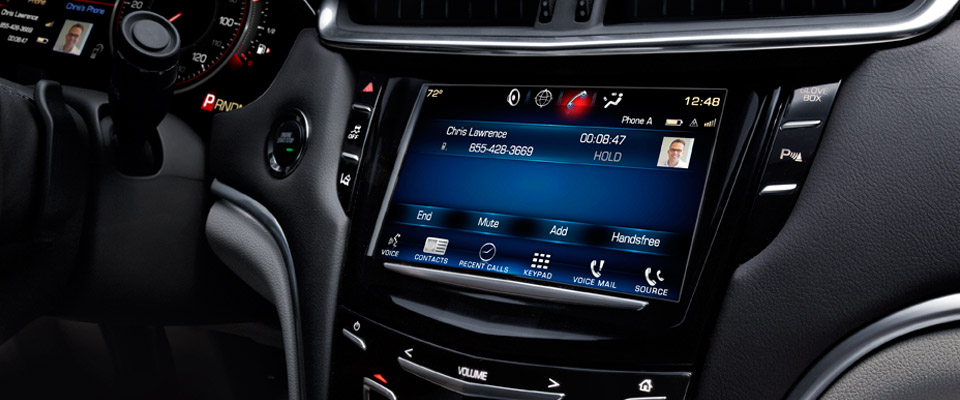This month, GM is shipping a 2013 Cadillac XTS sedan that is “technologically gee-whizzed to the gills,” according to USA Today. Novelties include adaptive headlights, ten airbags, and a driver’s seat that vibrates in different locations depending on the direction in which sensors detect a possible collision. Yet the highlight is a Debian Linux-based in-vehicle infotainment (IVI) system called Cadillac User Experience (CUE).
 CUE, which will also ship this fall on Cadillac’s ATS and SRX models, is not the first Linux-based automotive computer to reach market. Yet, earlier systems have been largely aimed at navigation, telematics, and fleet management on commercial trucks. CUE also supports telematics and navigation, but extends functionality to infotainment and communications. It’s the first fully-featured, open source IVI system to reach market, and judging by early reviews, probably the most sophisticated IVI system to date.
CUE, which will also ship this fall on Cadillac’s ATS and SRX models, is not the first Linux-based automotive computer to reach market. Yet, earlier systems have been largely aimed at navigation, telematics, and fleet management on commercial trucks. CUE also supports telematics and navigation, but extends functionality to infotainment and communications. It’s the first fully-featured, open source IVI system to reach market, and judging by early reviews, probably the most sophisticated IVI system to date.
According to GM, CUE offers the first “fully” capacitive touchscreen in an original-equipment car system. A triple-core ARM11 processor controls an eight-inch capacitive multi-touch display, supporting swipe, pinch-and-zoom, and drag-and-drop. An optional 12.3-inch cluster display, controlled by steering-wheel toggles, shows infotainment and communications status, as well as graphical readouts for fuel levels, speed, and other telematics functions. The system also integrates with the car’s OnStar telematics and safety system.
Other innovative features are intended to keep the driver’s eyes on the road. These include haptic feedback, Nuance-based natural language voice recognition, and text-to-speech support for email and text messages. There’s even a proximity sensing system that displays command icons only when one’s hand approaches the display.
The Open Source Challenger
CUE embraces its Linux foundation by showing users how to download an open source toolkit to start developing custom apps. “Unlike other automakers, who look to first establish partnerships with app developers, GM is forging ahead into a brave new world,” notes The Car Connection in reference to the toolkit. “And it may very well end up with the coolest apps.”
Open source IVI platforms like CUE may soon challenge Microsoft and other homegrown proprietary platforms. A number of car manufacturers, including BMW, are expected to roll out IVI systems over the next few years based on the open source, Linux-based Genivi Alliance spec. (Although GM is a Genivi member, CUE does not appear to be based on the spec.) Android is another promising platform for automotive, with Renault due to offer an Android-based R-Link system in its Zoe and Clio cars later this year.
Worldwide automotive infotainment revenue is projected to rise 3 percent to $33.5 billion in 2012, according to a February report from IHS iSuppli. Over the next four years, growth rates are projected to rise to between 4.7 to 6.4 percent, with the 2016 market expected to reach $41.2 billion.
Reviews CUE up the accolades
So far, the mostly favorable XTS reviews that appeared over the last week, following the sedan’s formal pricing ($44K and up), hint at a promising future for the Linux platform. Reviewers seemed far more impressed with CUE than with the huge car’s relatively underpowered V6 engine. Edmunds Inside Line calls CUE “logical and intuitive,” and AutoGuide proclaims CUE to be “perhaps the most significantly new user interface since iDrive rocked the auto world in 2001.”
The reviews compare CUE favorably to BMW’s iDrive and Ford’s MyFord Touch and MyLincoln Touch IVI systems, all of which are based on Microsoft technology. “CUE is graced with quick responses and a logical menu setup that makes it a lot less obtuse than the conceptually similar MyFord Touch system,” states Car and Driver.
According to The Car Connection’s test drive, entitled “2013 Cadillac XTS: Is CUE The Best Touch-Screen Interface Yet?”, CUE presented “no major hangups, or distractions.” The review praises CUE for its elegant look and feel, tablet-like touch performance, superior voice recognition system, and extensive customization features. The latter are said to include the ability to bookmark some of the 60 available functions and apps for easier access.
Many of the reviews note some latency in certain functions, as well as some Bluetooth-related hiccoughs. Presumably, however, over-the-air updates will cure many of these ills just as MyFord Touch has improved greatly since its debut.




